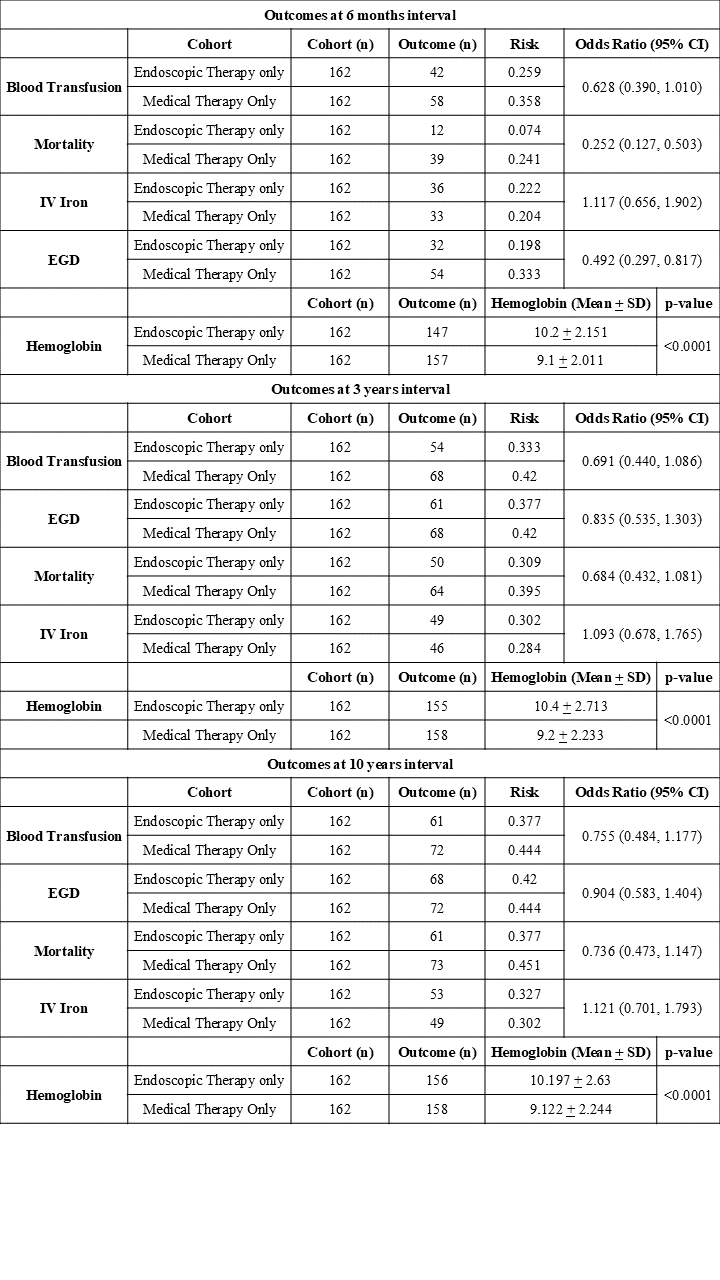Monday Poster Session
Category: GI Bleeding
P3080 - Initial Endoscopic Therapy Alone May Be a Factor in Maintaining Hemoglobin Levels When Treating Upper Gastrointestinal Angioectasias Associated With Iron Deficiency Anemia
Monday, October 27, 2025
10:30 AM - 4:00 PM PDT
Location: Exhibit Hall

Muhammad Shikaib Shabbir, MD (he/him/his)
University of California Riverside School of Medicine
San Bernardino, CA
Presenting Author(s)
Muhammad Shikaib. Shabbir, MD1, Umyma Naz, MBBS2, Christian Jackson, MD3
1University of California Riverside School of Medicine, San Bernardino, CA; 2Aziz Fatimah Medical and Dental College, Faisalabad, Punjab, Pakistan; 3VA Loma Linda Healthcare System, Loma Linda, CA
Introduction: Chronic gastrointestinal bleeding secondary to angioectasias of the upper gastrointestinal tract is a common cause of iron deficiency anemia. Our primary aim was to evaluate outcomes of endoscopic versus medical therapy at certain time intervals to determine their effect on clinical variables.
Methods: This is a retrospective cohort study utilizing TriNetX. ICD-10 codes were used to identify patients with angioectasias of the upper gastrointestinal tract (stomach and duodenum), while excluding patients with Dieulafoy’s lesion of the stomach, malignancy of the stomach, angioectasias of the colon, bevacizumab, and thalidomide. Patients were also required to have a concomitant diagnosis of iron deficiency and must have received at least one blood or iron transfusion (IV iron). Patients were subsequently divided into two groups: endoscopic and medical therapy. To ensure that somatostatin analogues were used specifically for angioectasias, patients with variceal bleeding (primary or secondary) were also excluded from both the cohorts. Propensity score matching was done for various variables. The statistical analysis was done using TriNetX with outcomes expressed as adjusted odds ratio.
Results: At 6-months, patients receiving endoscopic therapy alone demonstrated significantly lower rates of mortality (7.4% vs. 24.1%, OR 0.252, 95% CI 0.127–0.503), and need for EGDs (19.8% vs. 33.3%, OR 0.492, 95% CI 0.297–0.817) compared to those treated with medical therapy alone. There was no significant difference in IV iron use or blood transfusion. Mean hemoglobin was significantly higher in the endoscopic group (10.2 ± 2.15 vs. 9.1 ± 2.01, p < 0.0001). At 3 years, there was no difference in blood transfusion, mortality, EGD, and IV iron use. Hemoglobin remained significantly higher in the endoscopic group (10.4 ± 2.71 vs. 9.2 ± 2.23, p < 0.0001). At 10 years, there was no statistically significant difference in mortality, EGDs, blood transfusion, and IV iron use. Hemoglobin levels continued to favor endoscopic therapy (10.20 ± 2.63 vs. 9.12 ± 2.24, p < 0.0001).
Discussion:
Conclusion:
Endoscopic therapy may demonstrate an advantage over medical therapy in short-term outcomes in maintenance of hemoglobin, there was no long-term effect on mortality, blood transfusions, need for intravenous iron infusions, and EGD. Prospective, multicenter randomized controlled trials will need to be performed for further validation.

Figure: Comparative Analysis of Outcomes in Patients with Endoscopic and Medical Therapy at 6 months, 3 years, and 10 years
Disclosures:
Muhammad Shabbir indicated no relevant financial relationships.
Umyma Naz indicated no relevant financial relationships.
Christian Jackson indicated no relevant financial relationships.
Muhammad Shikaib. Shabbir, MD1, Umyma Naz, MBBS2, Christian Jackson, MD3. P3080 - Initial Endoscopic Therapy Alone May Be a Factor in Maintaining Hemoglobin Levels When Treating Upper Gastrointestinal Angioectasias Associated With Iron Deficiency Anemia, ACG 2025 Annual Scientific Meeting Abstracts. Phoenix, AZ: American College of Gastroenterology.
1University of California Riverside School of Medicine, San Bernardino, CA; 2Aziz Fatimah Medical and Dental College, Faisalabad, Punjab, Pakistan; 3VA Loma Linda Healthcare System, Loma Linda, CA
Introduction: Chronic gastrointestinal bleeding secondary to angioectasias of the upper gastrointestinal tract is a common cause of iron deficiency anemia. Our primary aim was to evaluate outcomes of endoscopic versus medical therapy at certain time intervals to determine their effect on clinical variables.
Methods: This is a retrospective cohort study utilizing TriNetX. ICD-10 codes were used to identify patients with angioectasias of the upper gastrointestinal tract (stomach and duodenum), while excluding patients with Dieulafoy’s lesion of the stomach, malignancy of the stomach, angioectasias of the colon, bevacizumab, and thalidomide. Patients were also required to have a concomitant diagnosis of iron deficiency and must have received at least one blood or iron transfusion (IV iron). Patients were subsequently divided into two groups: endoscopic and medical therapy. To ensure that somatostatin analogues were used specifically for angioectasias, patients with variceal bleeding (primary or secondary) were also excluded from both the cohorts. Propensity score matching was done for various variables. The statistical analysis was done using TriNetX with outcomes expressed as adjusted odds ratio.
Results: At 6-months, patients receiving endoscopic therapy alone demonstrated significantly lower rates of mortality (7.4% vs. 24.1%, OR 0.252, 95% CI 0.127–0.503), and need for EGDs (19.8% vs. 33.3%, OR 0.492, 95% CI 0.297–0.817) compared to those treated with medical therapy alone. There was no significant difference in IV iron use or blood transfusion. Mean hemoglobin was significantly higher in the endoscopic group (10.2 ± 2.15 vs. 9.1 ± 2.01, p < 0.0001). At 3 years, there was no difference in blood transfusion, mortality, EGD, and IV iron use. Hemoglobin remained significantly higher in the endoscopic group (10.4 ± 2.71 vs. 9.2 ± 2.23, p < 0.0001). At 10 years, there was no statistically significant difference in mortality, EGDs, blood transfusion, and IV iron use. Hemoglobin levels continued to favor endoscopic therapy (10.20 ± 2.63 vs. 9.12 ± 2.24, p < 0.0001).
Discussion:
Conclusion:
Endoscopic therapy may demonstrate an advantage over medical therapy in short-term outcomes in maintenance of hemoglobin, there was no long-term effect on mortality, blood transfusions, need for intravenous iron infusions, and EGD. Prospective, multicenter randomized controlled trials will need to be performed for further validation.

Figure: Comparative Analysis of Outcomes in Patients with Endoscopic and Medical Therapy at 6 months, 3 years, and 10 years
Disclosures:
Muhammad Shabbir indicated no relevant financial relationships.
Umyma Naz indicated no relevant financial relationships.
Christian Jackson indicated no relevant financial relationships.
Muhammad Shikaib. Shabbir, MD1, Umyma Naz, MBBS2, Christian Jackson, MD3. P3080 - Initial Endoscopic Therapy Alone May Be a Factor in Maintaining Hemoglobin Levels When Treating Upper Gastrointestinal Angioectasias Associated With Iron Deficiency Anemia, ACG 2025 Annual Scientific Meeting Abstracts. Phoenix, AZ: American College of Gastroenterology.
